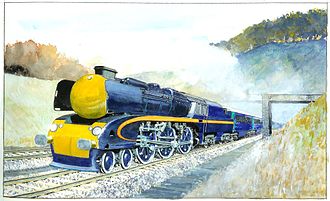5AT Advanced Technology Steam Locomotive

The 5AT locomotive illustrated in its final form.
|
|||||||||||||||||||||||||||||||||||
|
|||||||||||||||||||||||||||||||||||
|
|||||||||||||||||||||||||||||||||||
|
|||||||||||||||||||||||||||||||||||
| Type and origin | |
|---|---|
| Power type | Steam |
| Designer | David Wardale |
| Specifications | |
|---|---|
| Configuration | 4-6-0 |
| Gauge | 4 ft 8 1⁄2 in (1,435 mm) |
| Leading dia. | 3 ft 0 in (0.914 m) |
| Driver dia. | 6 ft 2 in (1.880 m) |
| Axle load | 20 tonne |
| Adhesive weight | 60 tonne |
| Loco weight | 80 long tons 0 cwt (179,200 lb or 81.3 t) |
| Total weight | 160 long tons 0 cwt (358,400 lb or 162.6 t) |
| Fuel type | Light Oil or Coal |
| Fuel capacity | 7 long tons 0 cwt (15,700 lb or 7.1 t) |
| Water cap | 10,000 imperial gallons (45,000 l; 12,000 US gal) |
| Boiler pressure | 305 psi (2.10 MPa) |
| Cylinders | Two |
| Cylinder size | 17.72 in × 31.5 in (450 mm × 800 mm) |
| Loco brake | Air |
| Train brakes | Air |
| Performance figures | |
|---|---|
| Maximum speed | 113 mph (Max Design Speed 125 mph) |
| Tractive effort | 32,688 lbf (145.40 kN) |
| Factor of adh. | 4 approx |
The 5AT Advanced Technology steam locomotive is a conceptual design conceived by the British engineer David Wardale, and first described in his definitive work on modern steam, The Red Devil and Other Tales from the Age of Steam.
Wardale's purpose in putting forward the "Super Class 5 4-6-0" design concept (as he then called it) was to offer a future for steam hauled trains on the main lines in the UK on which the use of heritage traction is likely to be gradually phased out as the speed and density of commercial rail traffic increase.
Work on the project was suspended in March 2012 following completion of a project Feasibility Study and subsequent failure to raise the finance needed to complete the detail design and construction of the locomotive.
Wardale's proposal was for a locomotive that would:
The April 1998 edition of the Steam Railway magazine contained an article by Wardale titled "Whither Steam Now?" which included reference to a "locomotive of Class 5 4-6-0 format - calling it a 5GT - that would outperform any British Pacific."
Still described as the 5GT in a Feb 2001 Railway Magazine article titled "Wardale reveals £1.7 million 'new steam' proposal for the heritage market", the name 5AT first emerged in a letter from Alan Fozard to the editor of Steam Railway Magazine issue 259 in June–July 2001, which coincided with the formation of the 5AT Project.
The 5AT in its final conceptual form remained almost identical in size and weight to the BR 5MT, sharing the axle spacings and being just 4 tonnes heavier, with axle loads of 20 tonnes on each driving axle and 10 tonnes on each bogie axle. Where it differed in size from the 5MT was in its tender which was massively enlarged to carry large quantities of fuel and water to extend its operating range. Such a large tender would also have provided space for the locomotive-carried parts of advanced signalling systems such as ERTMS. The 5AT's four-axle tender would have had a gross weight of 80 tonnes with a fuel (light-oil) capacity of 7 tonnes and water capacity of 46 tonnes (12,000 US gallons).
The 5AT Project was established in 2001 with the aim of commercializing Wardale's 5AT locomotive concept and bringing it to reality. The project was spearheaded by a small team of professional engineers, scientists and businessmen and women whose common purpose was to see steam traction continue in main-line operation into the foreseeable future.
...
Wikipedia
